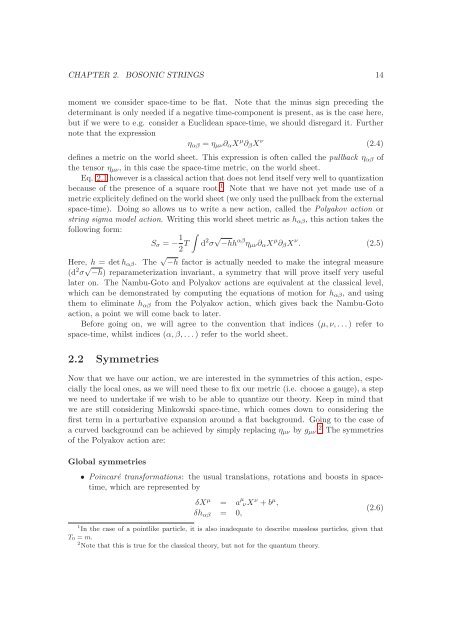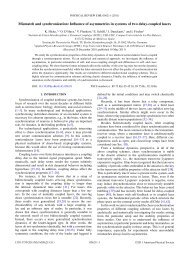DBI Analysis of Open String Bound States on Non-compact D-branes
DBI Analysis of Open String Bound States on Non-compact D-branes
DBI Analysis of Open String Bound States on Non-compact D-branes
You also want an ePaper? Increase the reach of your titles
YUMPU automatically turns print PDFs into web optimized ePapers that Google loves.
CHAPTER 2. BOSONIC STRINGS 14moment we c<strong>on</strong>sider space-time to be flat. Note that the minus sign preceding thedeterminant is <strong>on</strong>ly needed if a negative time-comp<strong>on</strong>ent is present, as is the case here,but if we were to e.g. c<strong>on</strong>sider a Euclidean space-time, we should disregard it. Furthernote that the expressi<strong>on</strong>η αβ = η µν ∂ α X µ ∂ β X ν (2.4)defines a metric <strong>on</strong> the world sheet. This expressi<strong>on</strong> is <str<strong>on</strong>g>of</str<strong>on</strong>g>ten called the pullback η αβ <str<strong>on</strong>g>of</str<strong>on</strong>g>the tensor η µν , in this case the space-time metric, <strong>on</strong> the world sheet.Eq. 2.1 however is a classical acti<strong>on</strong> that does not lend itself very well to quantizati<strong>on</strong>because <str<strong>on</strong>g>of</str<strong>on</strong>g> the presence <str<strong>on</strong>g>of</str<strong>on</strong>g> a square root. 1 Note that we have not yet made use <str<strong>on</strong>g>of</str<strong>on</strong>g> ametric explicitely defined <strong>on</strong> the world sheet (we <strong>on</strong>ly used the pullback from the externalspace-time). Doing so allows us to write a new acti<strong>on</strong>, called the Polyakov acti<strong>on</strong> orstring sigma model acti<strong>on</strong>. Writing this world sheet metric as h αβ , this acti<strong>on</strong> takes thefollowing form:S σ = − 1 2 T ∫d 2 σ √ −hh αβ η µν ∂ α X µ ∂ β X ν . (2.5)Here, h = det h αβ . The √ −h factor is actually needed to make the integral measure(d 2 σ √ −h) reparameterizati<strong>on</strong> invariant, a symmetry that will prove itself very usefullater <strong>on</strong>. The Nambu-Goto and Polyakov acti<strong>on</strong>s are equivalent at the classical level,which can be dem<strong>on</strong>strated by computing the equati<strong>on</strong>s <str<strong>on</strong>g>of</str<strong>on</strong>g> moti<strong>on</strong> for h αβ , and usingthem to eliminate h αβ from the Polyakov acti<strong>on</strong>, which gives back the Nambu-Gotoacti<strong>on</strong>, a point we will come back to later.Before going <strong>on</strong>, we will agree to the c<strong>on</strong>venti<strong>on</strong> that indices (µ, ν, . . .) refer tospace-time, whilst indices (α, β, . . .) refer to the world sheet.2.2 SymmetriesNow that we have our acti<strong>on</strong>, we are interested in the symmetries <str<strong>on</strong>g>of</str<strong>on</strong>g> this acti<strong>on</strong>, especiallythe local <strong>on</strong>es, as we will need these to fix our metric (i.e. choose a gauge), a stepwe need to undertake if we wish to be able to quantize our theory. Keep in mind thatwe are still c<strong>on</strong>sidering Minkowski space-time, which comes down to c<strong>on</strong>sidering thefirst term in a perturbative expansi<strong>on</strong> around a flat background. Going to the case <str<strong>on</strong>g>of</str<strong>on</strong>g>a curved background can be achieved by simply replacing η µν by g µν . 2 The symmetries<str<strong>on</strong>g>of</str<strong>on</strong>g> the Polyakov acti<strong>on</strong> are:Global symmetries• Poincaré transformati<strong>on</strong>s: the usual translati<strong>on</strong>s, rotati<strong>on</strong>s and boosts in spacetime,which are represented byδX µ = a µ νX ν + b µ ,δh αβ = 0,(2.6)1 In the case <str<strong>on</strong>g>of</str<strong>on</strong>g> a pointlike particle, it is also inadequate to describe massless particles, given thatT 0 = m.2 Note that this is true for the classical theory, but not for the quantum theory.
















